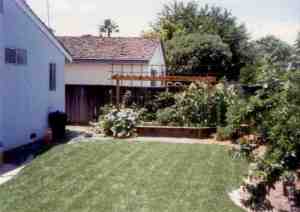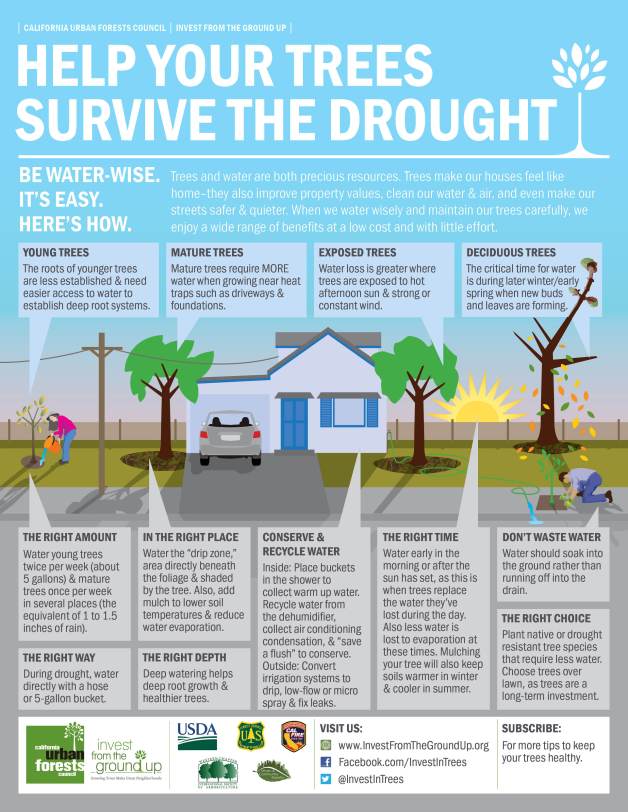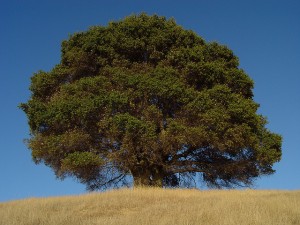Over the past few weeks we’ve been posting articles about how to keep your landscaping looking great during the drought. Today, we thought we would put that information into action in our own yard.

Here is what our landscape looked like before the drought.
The first thing we needed to do was some math to decide how much water our current landscape was using to find out how we could reduce that number. Here are the calculations Jeff came up with:
“As a Landscape Irrigation Auditor and Architect, part of my job is to estimate landscape water use when I design a project. This approach can also be used when evaluating an existing landscape.
“For our project I wanted to look at how much water the old lawn needed to remain healthy and to estimate the water need for a new landscape based on the anticipated plant selection. Below are those calculations to give you some idea on how much water can be saved.
“There are many variables when it comes to water use: local evapotranspiration, or the water which is evaporated and transpired through the leaves of the plants; plant factors, or the amount of water a plant needs to be healthy; hydrozoning, or grouping plants with like water needs together; and irrigation efficiency, or how effective our system is.
“So with our plan to remove the old lawn and plant with a combination of low water need plants and edibles, the calculations below give us an idea of how much water can be saved with proper preparation and water management.
ETWU (Estimated Water Use)
(This is based on removal of our old lawn 14’ x 34’ or 476 sf)
ETWU = (Eto) x (0.62) [PF x HA + SLA]
IE
Eto = evaptranspiration rate (45.3 annual)
0.62 = conversion factor
PF = plant factor
HA = hydrozone area (high, medium, low water needs by square foot)
SLA = special landscape area (edibles in square feet)
IE = irrigation efficiency (.85 for proposed drip application. 75 for lawn heads)
Hydrozone – as a lawn – high water need
(45.3)(0.62)[.7 x 476] + 0 = 28.08 x 444.26 = 12,475 gallons per year
.75
Hydrozone – if modified to low water need plants only
(45.3)(0.62)[.3 x 476] + 0 = 28.08 x 167.64 = 4,708 gallons per year
.85
Hydrozone – if modified to combination of low water need plants and edibles
(45.3)(0.62)[.3 x 412] + 64 = 28.08 x 145.41 + 64 = 4,083 + 64 = 4,147 gallons per year
.85
“From these calculations, as the new plants mature, we can conserve almost two thirds the amount of water (or 8,000 gallons of water per year) as required by the lawn. Now I love a lawn as much as the next person. It provides an area for play, gathering, etc., but this is the step we decided to take to help lower our water use and to do our part as we work through the drought. If we all could do something similar, even on a small level such as this, in the City of San Jose alone, with 1 million of us, we could conserve hundreds of millions of gallons of water per year. ”
After crunching these numbers it was a pretty easy decision to let the lawn go. But what to put in its place? We currently have two twenty-eight year old redwood trees, two California heritage prune trees, an orange and a lemon tree, plus a side yard filled with an olalleiberry bush. We want to protect all of these things despite letting the lawn go and find a more water-friendly way to sustain our existing landscape.

This is what our landscape currently looks like now that we have let the lawn die out. (And trees have matured)
To replace the lawn, we decided we would built two raised beds and plant edibles like herbs and vegetables. This way not only are we saving water, but we also get to save a little money at the grocery store! With the changes we are making, we will also continue to provide habitat for birds, butterflies and bees while also adding to our food harvest. Through these kinds of changes to our garden, and more importantly to our way of thinking, we can conserve enough water to continue to have a vibrant, attractive garden. One that is manageable and one that continues to provide an important environment for us all.
Look for what you can do as we share our process and next steps.






 While “Brown is the New Green” becomes our state motto and more people opt to stop watering their lawns, how are we supposed to continue caring for our trees? Lawns are easily replaceable but trees are an important part of our ecosystem providing wildlife habitats, clean air, shade, food for us and for critters, and therefore need to be protected. So how do we do that without breaking the bank and keeping under water restrictions? Patrice Hanlon of the Mercury News has some great tips:
While “Brown is the New Green” becomes our state motto and more people opt to stop watering their lawns, how are we supposed to continue caring for our trees? Lawns are easily replaceable but trees are an important part of our ecosystem providing wildlife habitats, clean air, shade, food for us and for critters, and therefore need to be protected. So how do we do that without breaking the bank and keeping under water restrictions? Patrice Hanlon of the Mercury News has some great tips: